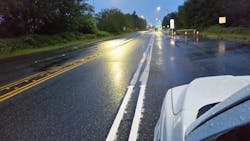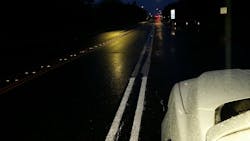Pavement Markings to Support Advanced Driver Assistive Systems (ADAS) and Safety
Consider the following outrageous hypothetical situation: “When it rains at night, new high-tech headlights automatically reduce their light output by half.” That would be … suboptimal.
But that is somewhat analogous to the situation drivers have been dealing with when trying to see roadway stripes at night during rainy conditions. Lane keeping /lane assist machine vision systems must also deal with a reduced ability to see roadway stripes on rainy nights as these new high-tech systems work to help keep vehicles on the road.
Glass beads
Glass beads have been used since the beginning of time in roadway striping and markings so why do most traditional roadway striping applications get harder to see when it rains at night? Much of the reason involves the optical properties of traditional glass beads. These beads are dropped onto wet roadway paint as striping trucks apply roadway delineation and markings. Under dry night conditions, these glass beads very effectively retro-reflect headlight energy back to the driver’s eye so they can follow the road but if the beads get wet, the effect is that their optical properties change such that headlight energy isn’t very well directed back to drivers or machine vision systems. Until the last decade, nothing could be done about this rain induced optical phenomenon.
During the last decade, special non-glass beads were developed by the roadway markings and delineation industry that continue returning headlight energy back to the driver during wet roadway conditions. However, these new, non-glass wet performing beads do not work as well during dry conditions. Therefore, traditional glass beads are blended with new wet performing beads to produce a mix of beads that, when installed on freshly painted lines, allow drivers and machine vision systems to see roadway markings farther down the road during both wet and dry night conditions. But not all areas of the country suffer frequent wet night conditions.
In areas that have exceptionally wet climates, a wet performing bead mix is potentially a big deal for human and machine vision system users. The potential to deliver reductions in wet night run-off-the-road serious and fatal crashes is promising, but research has yet to narrow the focus into a six-month period of predominantly wet, night, northern state commute conditions. Also, past research into the wider versus brighter pavement markings has not typically debated a machine vision versus human driver perspective either. Washington may be one of the best places to demonstrate two different approaches to long-line all-weather delineation conspicuity betterment. Western Washington drivers must deal with abnormally high amounts of dark winter rainy conditions while just over the Cascade Mountain range, Eastern Washington experiences mostly dry night conditions. This is where the wider or brighter ideas may be tested side by side in one state.
Opportunities
Both human and machine vision systems are always on the lookout for more roadway striping contrast. More contrast and conspicuity provide more vision distance which allows more time to make driving decisions. While research gathered and summarized by the Washington State Department of Transportation (WSDOT) suggests that wider lines in drier areas can produce nearly triple-digit benefit-cost ratios when combined with a pavement overlay, wider lines can still produce about 30:1 benefit-cost advantage all on their own. So, if wider lines provide more contrast and safety performance in dry conditions, imagine the impact of brighter lines in areas of the country that experience extreme dark and wet conditions on a regular basis.
California and Oregon are two of many states that have already used these wet performing bead mixes. In fact, local agencies have also used this technology with tape and plastic striping applications. The city of Federal Way in Washington State is adding multiple locations with wet performing beads on plastic lines this year (2021).
Funding and national guidance
Replacing worn out delineation and markings has traditionally been a maintenance function. Any additional expense involved in expanding the weather conditions in which traditional delineation and markings can be effective would likely further strain maintenance budgets. Those familiar with the struggles of maintenance budgets nationwide will understand the difficulty of moving forward with either wet performing bead mixes or wider lines under these historically constrained budget realities. Looking forward, more funding for preservation and maintenance is needed in general but specifically for roadway striping and marking activities given the potential direct impact on safety and traffic operations.
With additional funding dedicated to enhanced safety performance of delineation and markings, states and local agencies will need to determine how best to allocate funds to attain the greatest positive effect for system users—both drivers and ADAS systems. That will not likely be a one-size-fits-all piece of guidance given the variables involved so it will be difficult for a national guide—like the Manual of Uniform Traffic Control Devices—to deliver such targeted betterment. Context-sensitive approaches will be needed.
Recommendations for Washington
With an understanding of the general direction both federal guidance and automated vehicle manufacturers are heading (with respect to delineation and markings visibility improvements for human and machine vision systems), WSDOT has developed two contextual roadway striping concepts. Rainy, western Washington could deploy a wet performing bead mix onto traditional 4-in.-wide lines but with thicker high build paint (which may last two seasons in some locations). On the drier, east side of the state, the approach could be to simply widen the line to 6 in. while using traditional waterborne paint thickness and traditional glass bead materials.
This program concept could start with rural highways and then include more of the system as efficacy is demonstrated with these two context-sensitive approaches.
Washington has a very robust safety culture with the staff and ability to design studies, gather data, and analyze statistically significant results, so look forward to one day reading more about how this works out.

